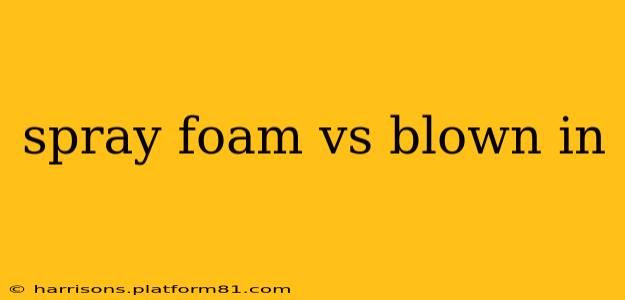Choosing the right insulation for your home is a crucial decision impacting energy efficiency, comfort, and long-term cost savings. Two popular options frequently top the list: spray foam insulation and blown-in insulation. Both offer excellent thermal performance, but they differ significantly in application, cost, and long-term benefits. This comprehensive guide will delve into the key differences to help you make an informed choice.
What is Spray Foam Insulation?
Spray foam insulation is a two-part liquid mixture that expands and hardens upon application. It seamlessly fills cracks and crevices, creating an airtight seal that significantly reduces air infiltration. This airtight seal is a major advantage, minimizing drafts and energy loss. There are two main types:
- Open-cell spray foam: Less expensive, offers good insulation, and allows for some vapor permeability.
- Closed-cell spray foam: More expensive, provides superior insulation, and creates a nearly impenetrable moisture barrier.
What is Blown-in Insulation?
Blown-in insulation, typically made of fiberglass or cellulose, is installed using a machine that blows the material into wall cavities, attics, and other areas. It's a less messy installation process compared to spray foam, often requiring less preparation. Fiberglass is a common, cost-effective choice, while cellulose, made from recycled paper, offers better fire resistance and sound absorption.
Spray Foam vs. Blown-in: Key Differences
| Feature | Spray Foam | Blown-in Insulation |
|---|---|---|
| Cost | Generally more expensive | Generally less expensive |
| Installation | More complex, requires specialized equipment | Relatively simpler, less specialized equipment |
| Air Sealing | Excellent, creates an airtight seal | Good, but may require additional sealing |
| Moisture Control | Excellent, especially closed-cell | Varies depending on material and installation |
| R-Value | High R-value per inch | Good R-value per inch, but can settle over time |
| Durability | Very durable, lasts for decades | Can settle over time, reducing effectiveness |
| Maintenance | Minimal | May require occasional topping up |
| Environmental Impact | Varies depending on the type of foam used | Cellulose is eco-friendly, fiberglass less so |
Which Type of Insulation is Better for My Home?
The "best" insulation depends entirely on your specific needs and priorities. Consider these factors:
- Budget: Blown-in insulation is typically the more affordable option.
- Energy Efficiency Goals: If maximizing energy efficiency is paramount, spray foam, particularly closed-cell, provides superior performance due to its airtight seal.
- Moisture Control: Homes in humid climates might benefit significantly from the moisture barrier provided by closed-cell spray foam.
- Ease of Installation: Blown-in insulation is easier and faster to install, resulting in less disruption.
What are the pros and cons of spray foam insulation?
Pros of Spray Foam Insulation:
- Superior air sealing: Creates a near-perfect air barrier, significantly reducing drafts and energy loss.
- High R-value: Offers excellent thermal performance, leading to lower energy bills.
- Moisture resistance: Closed-cell spray foam acts as a highly effective moisture barrier.
- Durability: Lasts for decades with minimal maintenance.
- Improved sound dampening: Reduces noise transmission between rooms and from outside.
Cons of Spray Foam Insulation:
- Higher cost: Significantly more expensive than blown-in insulation.
- Specialized installation: Requires experienced professionals with specialized equipment.
- Potential for off-gassing: Some types of spray foam can release VOCs (volatile organic compounds). Choose low-VOC or zero-VOC options to mitigate this.
What are the pros and cons of blown-in insulation?
Pros of Blown-in Insulation:
- Lower cost: More affordable than spray foam insulation.
- Easier installation: Less disruptive and faster installation process.
- Good R-value: Provides adequate thermal performance.
- Environmentally friendly options: Cellulose insulation is made from recycled materials.
Cons of Blown-in Insulation:
- Potential for settling: Can settle over time, reducing its effectiveness.
- Less effective air sealing: May require additional air sealing measures.
- May require topping up: Might need to be topped up after several years.
How much does spray foam insulation cost?
The cost of spray foam insulation varies significantly based on factors like the area to be insulated, the type of foam used (open-cell vs. closed-cell), and labor costs. It's always best to obtain multiple quotes from reputable installers in your area.
How much does blown-in insulation cost?
Similar to spray foam, the cost of blown-in insulation depends on factors such as the area to be insulated, the type of insulation used (fiberglass vs. cellulose), and labor costs. Getting multiple quotes is recommended to compare prices and services.
This information should help you make an informed decision about which insulation is best for your home. Remember to consult with qualified professionals for accurate assessment and installation advice tailored to your specific needs.
